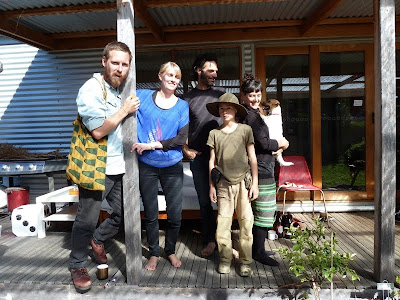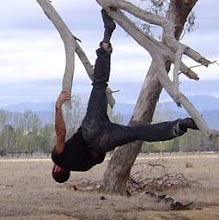I just came across this great little guide for identifying and treating disease and infestations in fruit and nut trees. From here.
Thursday, May 3, 2012
Perennial crop health
Labels:
infestations,
organic gardening,
perennial crops,
pest controllers,
tree health,
tree hygiene,
winter work
Sunday, April 15, 2012
The winter planting
While there's still warmth in the soil I thought I'd sow direct these heirlooms into our newly revamped produce area. In winter it is a sun trap until about 2pm.
Row one (closest to the house).
Row two.
Row three.
Row four.
Row five.
Before I sowed I turned over the soil with dolomite lime and blood and bone
Before laying down some straw and watering it all in. Around two sides Meg planted broad beans which we can tie against the fence.
Now with our winter seeds planted, our autumn produce booming (to the left and all around the garden), our summer onions, garlic, artichokes and potatoes stored in the cellar, and autumn and summer's fruit preserved in bottles or sun dried, we're ready for the cold dark spell.
Labels:
broad beans,
chooks,
heirloom seeds,
organic food,
produce,
soil improvement,
sowing seed,
winter food
Friday, November 25, 2011
The miracle bulb
We grew a year supply of garlic in just over 30sq m of ground. Our quarter acre equates to just over a 1000sq m, and as this is one of our most significant crops – medicinal and flavour punching – it really isn't much ground to use for half the year. The 30sq m of garlic was spread over 4 separate patches.
In our house if we feel a cold or flu coming on we munch on a raw clove of garlic before bed. 49 times out of 50 this treatment works. We rarely if ever get sick and we never have to take pharmaceuticals.
Saturday, November 19, 2011
After four years
Our garden is really kicking on this year, and I'm here to tell you (nothing new) organic food gardening has everything to do with the soil and its diversity of inputs. We used sheep poo and blood and bone with our winter's compost this year and the fruit trees and veggies are loving it. We have also had unusually warm and wet weather for this time of year.
This spring we've been eating from the garden the following: leek, onion, silver-beet, spinach, borage flowers, coriander, cabbage, broccoli, parsley, eggs, potatoes, broad beans, stinging nettle (pesto), asparagus, parsnip, fennel, lettuces, kohlrabi, sheep's sorrel, mints, peas, calendula flower, european sorrel, rosemary, carrots, mallow, mustard greens, wild radish, kale, and i even tried my first garden spider raw, which was quite lovely.
We don't actually require much animal protein to live on. Thanks spider, thanks chooks.
One of our hens went broody a month ago. Here are her joyous fruits (in a small ravin proof coop for now)...
This spring we've been eating from the garden the following: leek, onion, silver-beet, spinach, borage flowers, coriander, cabbage, broccoli, parsley, eggs, potatoes, broad beans, stinging nettle (pesto), asparagus, parsnip, fennel, lettuces, kohlrabi, sheep's sorrel, mints, peas, calendula flower, european sorrel, rosemary, carrots, mallow, mustard greens, wild radish, kale, and i even tried my first garden spider raw, which was quite lovely.
We don't actually require much animal protein to live on. Thanks spider, thanks chooks.
Labels:
chickens,
local food,
locavore,
organic eggs,
organic food,
produce,
relocalisation,
soil improvement
Tuesday, August 23, 2011
No Car! Suburban garden design (winter 2011)
NB: Driveway becomes an orchard, and eventually the continuation of the quarter acre food forest.
 I did this little sketch coming back from Tassie a month or two ago to prioritise the jobs that needed doing before spring. We now have bud burst and most of these things have been done, although still waiting for the Nothofagus that we ordered a month ago.
I did this little sketch coming back from Tassie a month or two ago to prioritise the jobs that needed doing before spring. We now have bud burst and most of these things have been done, although still waiting for the Nothofagus that we ordered a month ago.
 I did this little sketch coming back from Tassie a month or two ago to prioritise the jobs that needed doing before spring. We now have bud burst and most of these things have been done, although still waiting for the Nothofagus that we ordered a month ago.
I did this little sketch coming back from Tassie a month or two ago to prioritise the jobs that needed doing before spring. We now have bud burst and most of these things have been done, although still waiting for the Nothofagus that we ordered a month ago.
Saturday, July 16, 2011
Moon planting experiment
I know very little about planting by the moon, except for avoiding any planting after a full moon for about a week. So I decided to conduct an experiment. I planted about 50 onions on the eve of the full moon (yesterday). You can't see them in the below peg because they're still so small. I also planted leek, coriander, parsley, lettuce, cabbage and kohlrabi in this patch.
And then today I planted 10 more onions in a nearby patch (between garlic and a green manure of broad beans and oats). The patch was prepared in the same way as yesterday's. I only planted 10 here though because I don't want to waste the seedlings, or the ground space, in case they do badly.
Tuesday, June 14, 2011
Daylesford Community Food Garden
I set up a new blog, Just Free Food, on behalf of the Daylesford Community Food Gardeners, of which our household is part. Many of the 'gardening notes for relocalisation' are taking place over on that blog, but I will be updating our family food garden here as well, from time to time.
Tuesday, May 24, 2011
Rainbow over TreeElbow
Saturday, May 14, 2011
The citrus mound

This would have to be my most favourite part of the garden at the moment. Young oranges, grapefruits, a lemon and a loquat are planted as a copse with an understory planting of broad beans, calendula, nasturtiums, rhubarb, and edible self-planted floras such as mallow and chickweed. The photograph doesn't capture the incredible display of orange calendula flowers, that from the house, we look out onto, and which bring us unmeasurable delight.
Friday, April 29, 2011
From the home garden out – a survey as mindmap
Today I surveyed all the plants that feed and fuel us in our garden; that allow us to continue our four year boycott of supermarkets. I then made a drawing showing our household economy-ecology, extending out into the community and the commons.
This map demonstrates why the war on weeds is so antithetical to everything in the world, except of course to corporate profits.
Tuesday, April 26, 2011
Our recent SWAP cuts the ribbon on the SOI
Joel FitzGerald, with a capital 'G', came and stayed as the inaugural SWAP (social warming artists and permies) in the Shed of Interrelation.

We collected mushrooms, stinging nettle, chicken and horse manures to make a tea so as to mist each of the layers as we stacked green and brown materials (nitrogen and carbon) simultaneously. The misting with both the tea and rain water create an even moisture throughout the compost which help generate humidity.


The SoI is made largely from reclaimed, upcycled materials and is a small garden room built to host friends, peers, poets and artists to come and stay, contribute to our/their food and energy needs by working within our relocalising systems.
Joel brought with him valuable composting knowledge which has been keenly taken on and practiced since. One of his jobs in Sydney is working for councils, fixing methaney composts. Before his stay our composts would cook at a slow 35-40 degrees celsius. Now they're baking at about 60 degrees, fast tracking much needed fertile soil building. He also set a slower compost, collecting a pharmacopeia of barks and wild plants based on a biodynamic recipe. This will be an enhanced compost ready for the spring, he told me, as we set out to forage for the materials to build it.

Joel brought with him valuable composting knowledge which has been keenly taken on and practiced since. One of his jobs in Sydney is working for councils, fixing methaney composts. Before his stay our composts would cook at a slow 35-40 degrees celsius. Now they're baking at about 60 degrees, fast tracking much needed fertile soil building. He also set a slower compost, collecting a pharmacopeia of barks and wild plants based on a biodynamic recipe. This will be an enhanced compost ready for the spring, he told me, as we set out to forage for the materials to build it.

Collecting bark (above) and plantain (below) for the compost.

Two important things I learned about composting from Joel was keeping the pile small, so as to concentrate the heat, and the fine misting to help generate the humidity. These two things alone seem to account for the temperature hikes I can now get in my composts.



At the end of the build we bulked up the last layer of straw,

before putting the pile to bed for the winter.
Last weekend Joel returned with his girlfriend, Emma, and the SoI's cherry was well and truly popped.
Labels:
composting,
foraging,
relocalisation,
social warming,
SWAPs
Friday, March 18, 2011
Building a greenhouse from scratch
I was asked to make a greenhouse for Zeph's school, so I thought I'd document the process and share it with you.






With stakes and string lines we set out the site.

We popped the hose over the stakes and created a dome.

We fixed horizontals using a spacer to speed up the process.

The weight of the timber and laserlite flattened the dome.

Which was fixed with a central post and some angle bracing.
Thanks to Shay, Joe, Gabe and Zephyr for your help, and to Paul, the boys' teacher who said it was OK they stayed out of class to help. Yes, a rare and wonderful school.
I made a smaller, but similar structure at home last autumn using reclaimed materials. It's much smaller so you couldn't conduct a class in it. Nonetheless, any size greenhouse is helpful in cool climates, to keep food production going through the winter.
Tuesday, March 8, 2011
A twist on home-brew
I'm a fairly green home-brewer, in both senses, I'm only onto my fourth ever brew. But despite this I have a tip that doesn't seem to be common knowledge. If you buy twist top beer, save the bottles and the caps. They can both be reused again and again, cutting waste and expense. I can now confidently say the caps work as I've started to drink my first brew and have experienced the pleasure of my ales being released under pressure, with a twist of the wrist.


Labels:
beer,
home-brewing,
recycling,
Waste (non compostable)
Thursday, February 17, 2011
Our third year summer produce garden
All the effort we put into the soil over three years, although especially over the last winter and early spring, is now coming to fruition.
We're eating various beans and berries, zucchini, lettuce, tomato, leek, potato, parsley, chives, basil, garlic, plums, apples and wild herbs and vegetables such as mallow, plantain, rocket and sheep sorrel. This patch was planted by mixing up multiple companion seeds and sowing direct in the spring.
Click for bigger.
Monday, January 17, 2011
Our first SWAPs harvest chook bedding from self-renewing indigenous grasses
Meg recently worked with Su and Liz in the office at Melliodora and the conversation of WWOOFs (willing workers on organic farms) came up. Melliodora is not a registered wwoofing farm or garden, however regular travelers do come to learn more about permaculture, exchanging their labour for food and board just like ordinary wwoofs. One lunch break the gals got talking about a more appropriate acronym for the working travelers at Melliodora and Meg responded with MIAWs. Pretty soon they had collectively joined the dots – Melliodora Interns and Workers. Simple.
 The cut grass was then laid out on the driveway (that no longer requires car access) to dry, temporarily becoming a giant dog bed for Zero.
The cut grass was then laid out on the driveway (that no longer requires car access) to dry, temporarily becoming a giant dog bed for Zero.
 Elsewhere in the garden, after a week of torrential rain (and flooding in the area), the heirloom climbing beans reach for the sky.
Elsewhere in the garden, after a week of torrential rain (and flooding in the area), the heirloom climbing beans reach for the sky.
As we no longer travel by air, those who are still flying (for the right reasons – for reasons of social warming and exchange, not indulgence and exploitation) bring the world to us. Thank you Erikka and Maria for being our inaugural SWAPs, thank you for the warmth and ease and love that you brought to our town.
Just last week we were contacted by two lovely Swedish girls, Erikka and Maria, to see whether they could come and work in our garden. Errika had come to visit Melliodora the week before and had stayed with us as a guest. Despite not having our 'wwoofer' shack – the Shed of Interrelation – finished, we heartily agreed, and were so delighted to have them stay that it's got us moving again on setting up our garden exchange program as a wwoofing-type-experience-cum-artist-in-residence, particularly committed to rebuilding the relationship between ethics and aesthetics in a new era of permaculture.
This morning, after we had farewelled Maria and Erikka at the bus stop, I came up with the acronym SWAPs – social warming artists and permaculturalists – and that's exactly what Erikka and Maria were, or rather are, and that's exactly what we, Artist as Family, like to practice. The girls are on a permaculture study trip to Australia, and while they were here demonstrated an inherent understanding of how essential the interrelationships between bodies of knowledge are – especially between the arts and sciences – and especially if we are going to become more resilient to energy descent and climate chaos. Specialisation just isn't going to cut it.
The first job our SWAPs carried out was harvesting indigenous poa tussocks for our chooks' winter bedding. Here's Maria (left) and Erikka on dusk, savaged by mosquitos but tenacious and happy in their hand-scissor cutting work.
 The cut grass was then laid out on the driveway (that no longer requires car access) to dry, temporarily becoming a giant dog bed for Zero.
The cut grass was then laid out on the driveway (that no longer requires car access) to dry, temporarily becoming a giant dog bed for Zero. Elsewhere in the garden, after a week of torrential rain (and flooding in the area), the heirloom climbing beans reach for the sky.
Elsewhere in the garden, after a week of torrential rain (and flooding in the area), the heirloom climbing beans reach for the sky.
Subscribe to:
Posts (Atom)





























